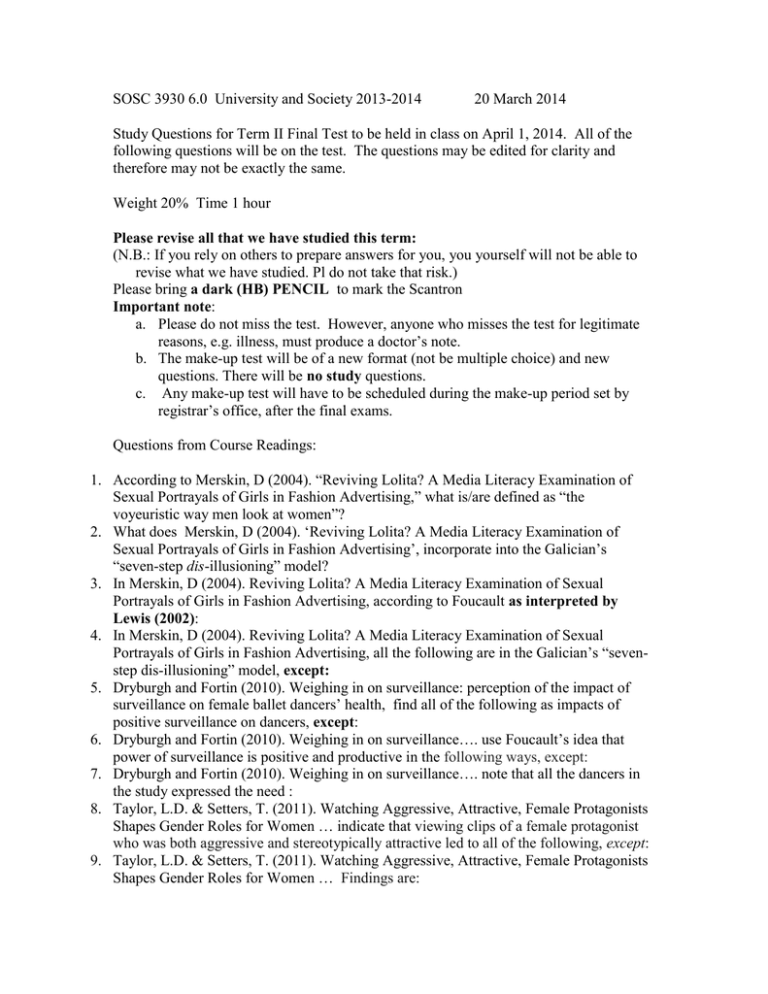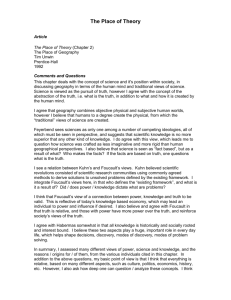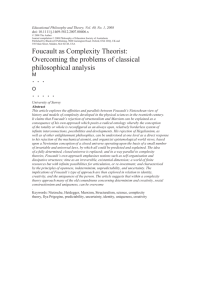
SOSC 3930 6.0 University and Society 2013-2014
20 March 2014
Study Questions for Term II Final Test to be held in class on April 1, 2014. All of the
following questions will be on the test. The questions may be edited for clarity and
therefore may not be exactly the same.
Weight 20% Time 1 hour
Please revise all that we have studied this term:
(N.B.: If you rely on others to prepare answers for you, you yourself will not be able to
revise what we have studied. Pl do not take that risk.)
Please bring a dark (HB) PENCIL to mark the Scantron
Important note:
a. Please do not miss the test. However, anyone who misses the test for legitimate
reasons, e.g. illness, must produce a doctor’s note.
b. The make-up test will be of a new format (not be multiple choice) and new
questions. There will be no study questions.
c. Any make-up test will have to be scheduled during the make-up period set by
registrar’s office, after the final exams.
Questions from Course Readings:
1. According to Merskin, D (2004). “Reviving Lolita? A Media Literacy Examination of
Sexual Portrayals of Girls in Fashion Advertising,” what is/are defined as “the
voyeuristic way men look at women”?
2. What does Merskin, D (2004). ‘Reviving Lolita? A Media Literacy Examination of
Sexual Portrayals of Girls in Fashion Advertising’, incorporate into the Galician’s
“seven-step dis-illusioning” model?
3. In Merskin, D (2004). Reviving Lolita? A Media Literacy Examination of Sexual
Portrayals of Girls in Fashion Advertising, according to Foucault as interpreted by
Lewis (2002):
4. In Merskin, D (2004). Reviving Lolita? A Media Literacy Examination of Sexual
Portrayals of Girls in Fashion Advertising, all the following are in the Galician’s “sevenstep dis-illusioning” model, except:
5. Dryburgh and Fortin (2010). Weighing in on surveillance: perception of the impact of
surveillance on female ballet dancers’ health, find all of the following as impacts of
positive surveillance on dancers, except:
6. Dryburgh and Fortin (2010). Weighing in on surveillance…. use Foucault’s idea that
power of surveillance is positive and productive in the following ways, except:
7. Dryburgh and Fortin (2010). Weighing in on surveillance…. note that all the dancers in
the study expressed the need :
8. Taylor, L.D. & Setters, T. (2011). Watching Aggressive, Attractive, Female Protagonists
Shapes Gender Roles for Women … indicate that viewing clips of a female protagonist
who was both aggressive and stereotypically attractive led to all of the following, except:
9. Taylor, L.D. & Setters, T. (2011). Watching Aggressive, Attractive, Female Protagonists
Shapes Gender Roles for Women … Findings are:
10. Yakaboski, T. (2011). “Quietly Stripping the Pastels”: The Undergraduate Gender Gap,
argues about the underlying power discourse as:
11. Yakaboski, T. (2011). “Quietly Stripping the Pastels”: The Undergraduate Gender Gap,
critiques the media’s “fact” for:
12. Yakaboski, T. (2011). “Quietly Stripping the Pastels”: The Undergraduate Gender Gap,
notes that the media expressed concerns that the gender gap would have the economic
impact of :
13. Yakaboski, T. (2011). “Quietly Stripping the Pastels”: The Undergraduate Gender Gap,
argues that the news media arena is :
14. In Vandermeersche, G., et al (2013). “Shall I tell you what is wrong with Hector…”
The main function of using school films for reflection is to stimulate:
15. In Vandermeersche, G., et al (2013). “Shall I tell you what is wrong with Hector…”
Henry Giroux, and Tillman and Trier favour using popular movies in teaching for the
following reasons, except?
16. In Hudson, S. & Elliot, C. (2013). Measuring The Impact Of Product Placement On
Children … the results show all the following except:
17. Hudson, S. & Elliot, C. (2013). Measuring The Impact Of Product Placement On
Children … analysis of the results indicate all below, except:
18. Seale, C. et.al. (2006). Commodification of Body Parts: By Medicine or by Media?
discusses the important role of biotechnology and mass media in contributing to the
commodification of body parts, as follows:
19. Seale, C. et.al. (2006). Commodification of Body Parts: By Medicine or by Media?
all the following rhetorical devices are used in press reports that have contributed to the
commodification of children’s human materials, except:
20. Cressida J. Heyes (2007): Cosmetic Surgery And The Televisual Makeover, explains the
Foucauldian ‘normalization’ in the reality show: Extreme Makeover’ as follows:
21. How does Cressida J. Heyes (2007): Cosmetic Surgery And The Televisual Makeover,
supports her argument that the TV makeover seems to persuade the women that it
embodies feminism’s own values?
22. In Coffey, J (2013). Bodies, body work and gender: Exploring a Deleuzian approach, the
following are his main arguments, except:
23. Coffey, J (2013), “Bodies, body work and gender: Exploring a Deleuzian approach”
presents all the findings from his interviews as follows, except:
24. Meyer, M.D.E., Fallah, A.M. & Wood, M.M. (2011). Gender, Media, and Madness:
Reading a Rhetoric of Women in Crisis Through Foucauldian Theory, identify as true all
of the following, except:
25. In Meyer, M.D.E., Fallah, A.M. & Wood, M.M. (2011). Gender, Media, and Madness:
Owen et al. (2007) (in Bad Girls: Cultural Politics and Media Representations of
Transgressive Women) deconstruct the coding of American female soldiers through films
with Gulf War narratives as all of the following, except:
26. Sears, C.A & Godderis, R. (2011). Roar Like a Tiger o TV? Constructions of Women
and child birth in Reality TV, indicate that Lifestyle programming has the potential to :
27. Sears, C.A & Godderis, R. (2011). Roar Like a Tiger o TV? Constructions of Women
and child birth in Reality TV, all the following are the authors’ findings on the woman
and the show A Baby Story, except:
28. Hansen, A.H. (2013). Time is but the stream I go a-fishing in… notes that the following
ideas of Carl Jung have been influential in the shows he discusses:
29. Hansen, A.H. (2013). Time is but the stream I go a-fishing in… identifies the following
Jungian theoretical themes in these shows?
30. According to Turner, B. (2006). Hospital, Problematizing Global Knowledge :
Hospitals:
31. Turner, B. (2006). Hospital, Problematizing Global Knowledge, identifies that with the
dominance of bio-medical sciences all the following occurred, except
32. Turner, B. (2006). Hospital, Problematizing Global Knowledge, explains the historical
setting for Michel Foucault’s Madness and Civilization (1971) and examins the
institutional development of organizations through all of the following statements,
except:
33. According Turner, B. (2006). Hospital, contradictions are present in all of the following
between medical ethic and making a profit, except in:
34. In Friedman, R.J. (2013. “A Moving-Picture of Democracy”…, what does Vachel
Lindsay’s “Mirror Screen” in The Art of the Moving Picture (1915) mean?
35. The thesis of Dubrofsky, R.J (2013). “Jewishness, Whiteness, and Blackness on Glee:
Singing to the Tune of Postracism”, argues all of the following, except:
36. According to Dubrofsky, R.J (2013). “Jewishness, Whiteness, and Blackness on Glee:
Singing to the Tune of Postracism,” how does the ‘‘money shot’’ underscore racism in
television shows?
37. According to Bossewitch, J & Sinnreich, A (2012). “The end of forgetting: Strategic
agency beyond the Panopticon,” Face Painters use obfuscation strategy for the following
reasons, except:
38. According to Bossewitch, J & Sinnreich, A (2012). “The end of forgetting: Strategic
agency beyond the Panopticon,” what is the impact of pervasive surveillance on the
society founded on lies?
Questions from the DVD
39. The film “Mickey Mouse Monopoly” identifies/argues all of the following as true about
Disney movies for children, except:
40. In the film “Mickey Mouse Monopoly,” Giroux and other critics regard Disney images
as:
41. Critics in the film “Mickey Mouse Monopoly” argue that children’s movies influence the
young in all of following ways except:
Questions from the lectures
42. According to T2 Lec 1, the purpose of the university are all of the following except:
43. According to T2 Lec 1, how does Foucault explain the role of “power” in society?
44. According to T2 Lec 1, Foucault emphasizes that the forces that drive our history operate
particularly on:
45. In T 2 Lec 2, we discussed that media become a disciplinary force as a result of all of the
following, except:
Questions related to the final essay class presentations ( Read: the three documents
on Foucault’s themes that are on the course web: 1. Foucault’s Concepts and
Arguments on ‘disciplining’ the body into a ‘Docile Body’; 2. Foucault’s concepts and
arguments on Power, Discipline, knowledge vs. Information, and Expertise. ); 3. Topics:
F’s conceptual Themes for your Essays P 1 & P 2
46. The presenters on how a body becomes docile should examine all of the following
mechanisms of discipline in the visual media, except:
47. The presenters on power/knowledge and truth or ethics should use (in analyzing visual
media ) Foucault’s arguments on the ruling and regulating power, except:
48. The presenters of visual representations on the topic: higher education and choice of
female disciplines, should use Foucault’s arguments on power that includes all of the
following, except
49. The presenters on visual representations on any social media related issues should use the
following Foucault’s concepts, except
50. The presenters on visual representations on the Expertise vs. Self-knowledge should use
the following Foucault’s themes, except







